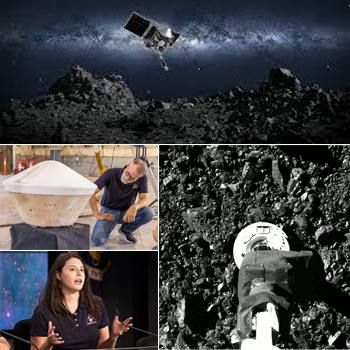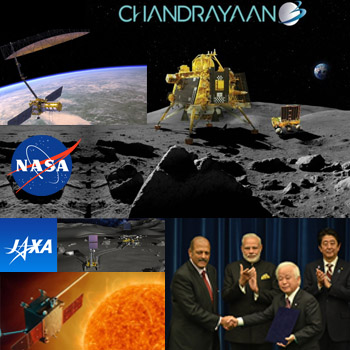First Asteroid Sample Retrieved by USA Set to Land in Utah Before Spacecraft Heads to Next Target |
MONDAY☆ Sep 18 — International Space Station, ~415-km LEO: Expedition 69 ten-member crew working with newly arrived NASA Astronaut Loral O’Hara, Roscosmos Cosmonauts Oleg Kononenko and Nikolai Chub. ☆ Sep 18 — Tiangong Space Station, ~390-km LEO: Shenzhou 16 three-member crew transferring Tianzhou-6 cargo after Tianzhou-5 undocking and atmosphere disintegration over the South Pacific. Highlights… o NewSpace: 23 companies in talks with Indian National Space Promotion and Authorisation Centre (IN-SPACe) to utilize Small Satellite Launch Vehicle; Exos Aerospace of Texas progressing toward 2024 reusable rocket launch following successful engine firing; Starlink partnering with SES to offer higher (1.5 / 3 Gbps per boat) bandwidth on cruise ships. ☆ Solar System: JAXA orbiter Akatsuki data suggests Venus flashes are meteors burning ~100 km above surface which pose little threat to probes like NASA DAVINCI launching NET 2029; 1-km diameter asteroid Dinkinesh now within view of Lucy spacecraft cameras from 23,000,000 km distance; UAE Astronaut Sultan Al Neyadi hopeful for involvement in a future Artemis lunar mission. ☆ Galaxy: UK astronomy team working with MIRI on JWST to validate intriguing bio markers (methane, carbon dioxide, dimethyl sulfide) of potentially Hycean exoplanet K2-18 b; Multi Unit Spectroscopic Explorer (MUSE) instrument on ESO VLT being used to observe Einstein Cross via gravitational lensing of massive elliptical galaxy; Amherst Collage astronomer Mia de los Reyes petitioning IAU to rename Large and Small Magellanic Clouds in light of indigenous genocide perpetuated by namesake. o Global: USA and India working to establish terms of space collaboration including commercial activities, human spaceflight and planetary protection; China to train Venezuela astronauts for crewed lunar mission, per Venezuela President Nicolas Maduro; Russia to assist North Korea on satellite launch following meeting of leaders at Vostochny Cosmodrome. ● USA: Astronaut Frank Rubio on track to set overall USA record for spaceflight duration at 371 days, having exceeded previous 355-day record; GSFC meteorologist Mark McInerney to serve as NASA Director of UAP Research; Aerojet Rocketdyne and NASA working to install RS-25 engines on Artemis 2 SLS core stage at Michoud Assembly Facility. ● Hawai’i: UH planetary scientist Shuai Li plans to verify water-related ion transfer from Earth to Moon detected via Chandrayaan-1 with future Artemis lunar payload; Chiba University study of data from Subaru, JWST, Euclid, eROSITA and others estimates universe comprised of 31% baryonic matter; FAA may approve 2nd Starship test flight to 100-km NW of Kaua’i in October. |
 |
● = Terrestrial and… o = International terrestrial events
☾ = Moon activity ★ = Space and… ☆ = International space / astro events in Hawaii Standard Time unless noted. Add 10 hours to obtain UT (‘Universal Time’). |
Weekly Planet Watch – Evening Planets: Venus (E), Jupiter (ENE), Saturn (SE), Uranus (E), Neptune (SE). Morning planets: Mercury (E).
India Builds on Success of Chandrayaan-3, Collaborates on Further Lunar Missions with USA, Japan
India Space Program looks forward to multiple upcoming space events with Chandrayaan-3 lander on Moon attempting to awaken from hibernation on September 22, first crewed ISRO Gaganyaan orbital test planned for late 2024, and collaboration with both NASA and JAXA on joint lunar missions. With successful landing on lunar South Pole August 23, ISRO Vikram lander reports lunar soil thermal readings of 50° C at the surface, and -10° C at 80 mm. ISRO plans further lander/rover missions to Moon South Pole jointly with JAXA on Lunar Polar Exploration Mission (LUPEX), also known as Chandrayaan-4, slated for launch NET 2026. The lander is being developed by ISRO and rover by JAXA which will be launched via Japan H3 rocket and aim to land at 89° S lunar south pole. Chandrayaan-5 may launch 2026-30, followed by Chandrayaan-6. Future phases of the human spaceflight program will intersect with Chandrayaan research / lessons for India human Moon missions. Potentially launching 2024, ISRO and NASA are collaborating NASA-ISRO Synthetic Aperture Radar (NISER) satellite to map Earth surface changes of movements as small as 1 cm, using L-band and S-band radar frequencies. ISRO also launched first dedicated ISRO solar mission Aditya-L1 this September. It is anticipated to arrive January 2024 to its planned L1 halo orbit ~1.5 million km from Earth, approximately 1% of Earth-sun distance. (Image Credits: ISRO, ESA, NISER, Organiser Weekly, ETV Bharat, NASA, JAXA) |
☆ Sep 18 — Venus: At brightest, magnitude -4.54°, 02:00. ☆ Sep 18 — Apollo Asteroid 2023 RV7: Near-Earth Flyby (0.027 AU). ☆ Sep 18 — Amor Asteroid 2023 RV9: Near-Earth Flyby (0.025 AU). Ongoing… ☾ Sep 6 – NET Jan/Feb — Smart Lander for Investigating Moon (SLIM), Lunar Landing Trajectory: SLIM Moon mission 3-4 month trajectory to soft land east of Shioli crater (13.2°S, 25.2°E) on Moon near side equatorial region. ☆ Sep 6 – NET Mar — X-Ray Imaging and Spectroscopy Mission (XRISM), ~550-km LEO: XRISM undergoing 6 month check out testing phase before start of science operations to study galactic plasma. ● Sep 17-19 — AMOS, Maui Economic Development Board, Millennium Space Systems, Boeing, AI Solutions, Trusted Space, et al, Maui HI: 2023 EMER-GEN Conference. TUESDAY● Sep 19-21 — NASA, Houston TX: Innovative Advanced Concepts (NIAC) Symposium. ● Sep 19-21 — TechCrunch, Aerospace Company, Google, Mercury, Samsung Next, et al, San Francisco CA: TechCrunch Disrupt 2023. ● Sep 19-22 — AMOS, Maui Economic Development Board, Millennium Space Systems, Boeing, AI Solutions, Trusted Space, et al, Maui HI: 2023 Advanced Maui Optical and Space Surveillance Technologies (AMOS) Conference. o Sep 19-22 — JAXA, Japan Ministry of Education, Culture, Sports, Science and Technology (MEXT), Indonesian Space Agency Secretariat (INASA), Indonesia National Research and Innovation Agency (BRIN), Jakarta, Indonesia: 29th Asia-Pacific Regional Space Agency Forum 2023. ☆ Sep 19 — Neptune: At opposition in longitude, 01:00. ☆ Sep 19 — Amor Asteroid 2023 RK3: Near-Earth Flyby (0.048 AU). WEDNESDAY● Sep 20 — Mars Exploration Program Analysis Group (MEPAG), NASA, Pasadena CA / Online: Virtual Meeting #17 MEAG. ● Sep 20-23 — Lunar Exploration Analysis Group (LEAG), NASA, Laurel MD / Online: 2023 Annual Meeting of LEAG. ☆ Sep 20 — Apollo Asteroid 2023 RP9: Near-Earth Flyby (0.005 AU). ☆ Sep 20 — Apollo Asteroid 2023 RAB: Near-Earth Flyby (0.036 AU). |
THURSDAY
★ Sep 21 — MAVEN, Mars Orbit: NASA Mars Atmosphere and Volatile Evolution (MAVEN) spacecraft reaches 9 full years / enters 10th year of operations in Mars orbit after insertion on this day 2014; continuing to study upper atmosphere.
● Sep 21-23 — American Museum of Natural History, Open Space, Lower Eastside Girls Club of New York, New York NY: Culturally Inclusive Planetary Engagement Workshop.
☆ Sep 21 — Moon: 0.95° NE of Antares, 00:00.
☆ Sep 21 — Apollo Asteroid 2023 RR6: Near-Earth Flyby (0.039 AU).
FRIDAY
☾ Sep 22 — Chandrayaan-3, Shiv Shakti Point, Moon: Vikram lander and Pragyan rover at 69.373°S, 32.319°E may awaken from hibernation today.
o Sep 22 — NASA, Canadian Space Agency, Salt Lake City UT: Media Invited to Participate in OSIRIS-REx Pre-landing News Conference and Photo Opportunity of Recovery Operations.
o Sep 22 — The Astronomical League, Global: Fall Astronomy Day; astronomical societies, planetariums, museums, observatories sponsoring public viewing sessions, presentations, workshops.
☆ Sep 22 — September Equinox: The Sun rises exactly in east traveling through sky for 12 hours, sets exactly in west; every place on Earth experiences a ~12-hour day, 20:50.
☆ Sep 22 — Moon: At first quarter, 09:31.
☆ Sep 22 — Apollo Asteroid 2023 RQ6: Near-Earth Flyby (0.040 AU).
SATURDAY
☆ Sep 23 — Mercury: At perihelion, 0.3075 AU from Sun, 08:00.
SUNDAY
★ Sep 24 — OSIRIS-REx, Earth Trajectory: Origins-Spectral Interpretation-Resource Identification-Security-Regolith Explorer (OSIRIS-REx) spacecraft scheduled to return to Earth / land at Utah Test and Training Range with asteroid sample of at least 60 grams.

